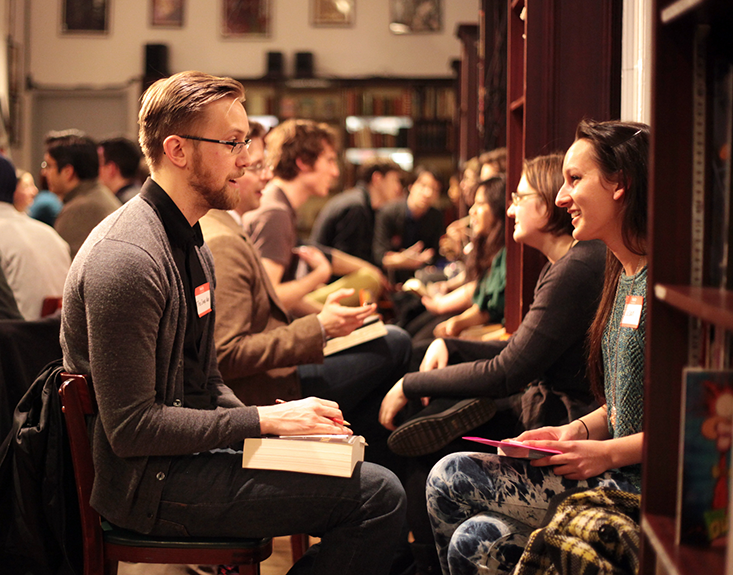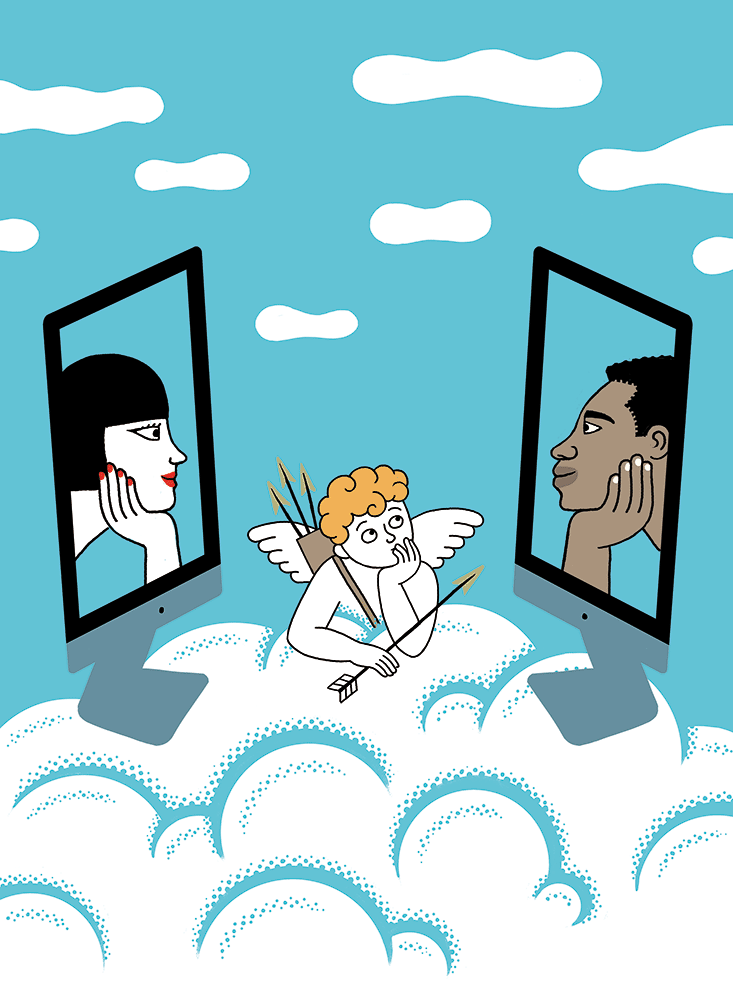Let’s get the basics over with,” W said to M when they met on a 4-minute speed date. “What are you studying?”
“Uh, I’m studying econ and poli sci. How about you?”
“I’m journalism and English literature.”
“OK, cool.”
“Yeah.”
They talked about where they were from (she hailed from Iowa, he from New Jersey), life in a small town, and the transition to college. An eavesdropper would have been hard-pressed to detect a romantic spark in this banal back-and-forth. Yet when researchers, who had recorded the exchange, ran it through a language-analysis program, it revealed what W and M confirmed to be true: They were hitting it off.

The researchers weren’t interested in what the daters discussed, or even whether they seemed to share personality traits, backgrounds, or interests. Instead, they were searching for subtle similarities in how they structured their sentences—specifically, how often they used function words such as it, that, but, about, never, and lots. This synchronicity, known as “language style matching,” or LSM, happens unconsciously. But the researchers found it to be a good predictor of mutual affection: An analysis of conversations involving 80 speed daters showed that couples with high LSM scores were three times as likely as those with low scores to want to see each other again.
It’s not just speech patterns that can encode chemistry. Other studies suggest that when two people unknowingly coordinate nonverbal cues, such as hand gestures, eye gaze, and posture, they’re more apt to like and understand each other. These findings raise a tantalizing question: Could a computer know whom we’re falling for before we do?
Decades of relationship research show that romantic success hinges more on how two people interact than on who they are or what they believe they want in a partner.
Picture this: You’re home from work for the evening. You curl up on the couch, steel your nerves, maybe pour yourself a glass of wine, and open the dating app on your phone. Then for 30 minutes or so, you commit to a succession of brief video dates with other users who satisfy a basic set of criteria, such as gender, age, and location. Meanwhile, using speech- and image-recognition technologies, the app tracks both your and your dates’ words, gestures, expressions, even heartbeats.
Afterward, you rate your dates. And so does the app’s artificial intelligence, which can recognize signs of compatibility (or incompatibility) that you might have missed. At the end of the night, the app tells you which prospects are worth a second look. Over time, the AI might even learn (via follow-up experiments) which combination of signals predicts the happiest relationships, or the most enduring.
Welcome to the vision of Eli Finkel. A professor of psychology and management at Northwestern University and a co-author of the LSM study, Finkel is a prominent critic of popular dating sites such as eHarmony and Chemistry, which claim to possess a formula that can connect you with your soul mate. Finkel’s beef with these sites, he says, isn’t that they “use math to get you dates,” as OKCupid puts it. It’s that they go about it all wrong. As a result, Finkel argues, their matching algorithms likely foretell love no better than chance.
The problem, he explains, is that they rely on information about individuals who have never met—namely, self-reported personality traits and preferences. Decades of relationship research show that romantic success hinges more on how two people interact than on who they are or what they believe they want in a partner. Attraction, scientists tell us, is created and kindled in the glances we exchange, the laughs we share, and the other myriad ways our brains and bodies respond to one another.
Which is why, according to Finkel, we’ll never predict love simply by browsing photographs and curated profiles, or by answering questionnaires. “So the question is: Is there a new way to leverage the Internet to enhance matchmaking, so that when you get face to face with a person, the odds that you’ll be compatible with that person are higher than they would be otherwise?”
The way Finkel sees it, online dating has evolved through three generations. He describes the first-generation sites, beginning with the 1995 launch of Match, as “supermarkets of love,” which invited customers to “come and browse the wares”—profiles of available men and women. But that approach, he says, relied on two faulty ideas.
First, it assumed that “people have insight into what actually will inspire their romantic attraction when they meet somebody.” In fact, people often say they desire certain qualities in a partner—wealth, perhaps, or an outgoing personality—but then choose someone who doesn’t fit that mold. In a laboratory experiment, for example, Finkel and his colleagues found that subjects expressed romantic interest in written profiles that reflected their stated preferences. But when they met potential partners face to face, they reported feeling attracted to people who didn’t necessarily match their ideals.
The second oversight of the supermarket model, Finkel says, was to assume that online profiles capture the characteristics that matter most in a relationship. While text and pictures readily convey “searchable” attributes such as income, religion, and physical appearance, they often overlook “experiential” traits such as loyalty, sense of humor, and mutual understanding. It’s no wonder, then, that a “perfect match” online often disappoints in person. As Finkel puts it: “It is difficult for an online dater to know whether he or she will like a potential partner based on knowledge of the partner’s searchable traits and interests, just as it is difficult for someone to know whether or not he or she will like a meal based on knowledge of the ingredients and nutritional content.”
There is scant evidence that similarities, particularly in personality traits, have much bearing on compatibility.
Second-generation dating sites, which debuted in the early 2000s, tried to overcome some of the limitations of the first generation by taking matchmaking into their own hands. These “real estate agents of love,” as Finkel calls them, purported to offer “particular expertise” that would “increase the odds that you’ll meet somebody who’s really compatible with you.” With its 300-item questionnaire and patented matching system, for instance, eHarmony promises that “each compatible match is pre-screened for you across 29 dimensions.” Similarly, Chemistry, a “premium offering” from Match, employs a pairing scheme developed by Helen Fisher. A biological anthropologist, Fisher has identified four personality types associated with particular brain chemistries, which she believes influence whom we like and fall in love with.
Finkel would tell you this is all a lot of hype. In a 2012 paper in the journal Psychological Science, he and his colleagues took Chemistry and its kin to task for failing to produce convincing scientific evidence that their matching algorithms make better matches. What’s more, the researchers argue, any algorithm based on individual traits is unlikely to predict romantic success. “We asked ourselves: ‘Could we even in principle imagine an algorithm that would actually work?’ ” Finkel says. “And we said ‘no.’ ”
One big reason, according to their review of published research, is that comparing two people’s personal qualities reveals little about how happy they will be together. Most matching sites pair users largely on the basis of similarity: Do they share values, lifestyles, experiences, passions, and temperaments? The assumption is that the more alike they are, the more likely they will get along. But clearly there are exceptions. “If you are an anxious, depressed, or insecure person, you have a hard time with anyone,” says Arthur Aron, a social psychologist at Stony Brook University. “Two people like that do even worse.”
More important, says Finkel, there is scant evidence that similarities, particularly in personality traits, have much bearing on compatibility. In an analysis of nationally representative samples of more than 23,000 people in Australia, Germany, and the United Kingdom, similarity between partners’ personalities predicted 0.5 percent of how satisfied they were in the relationship. “Half of 1 percent is pretty meager when companies are promising you your soul mate,” Finkel says.
If similarity isn’t a useful gauge of compatibility, then complementarity fares even worse. In 1958, the sociologist Robert Winch theorized that we are drawn to people who have qualities we value but lack in ourselves. The idea is appealing. Fisher, for instance, believes that two very different personality types—“Directors” (“analytical, direct, tough-minded, decisive, and emotionally contained”) and “Negotiators” (“imaginative, broad-minded, agreeable, and compassionate”)—make good matches. But beyond her own surveys of Chemistry users, proof of Winch’s hypothesis has been hard to come by. Studies consistently show that introverts aren’t always happier with extroverts. Nor does satisfaction depend on complementary attitudes, interests, spending habits, or gender roles.
Most relationship researchers agree that a lot more than personality determines whether two people will get together, or whether a relationship will last. “No questionnaire can do more than give you a group of people to look at,” Fisher says. “Nobody knows your childhood; nobody knows everything you’re looking for—your love map.” Also important, Aron says, are “the circumstances in which [two people] meet, what their family and friends think, and their actions at initial meetings.” And don’t forget the quality of their interactions, Finkel adds—how they communicate, resolve problems, and cope with stressors such as losing a job or having a baby.
Perhaps recognizing this complexity, the latest generation of dating sites—Tinder and its imitators—have abandoned elaborate algorithms and questionnaires for a simple recipe: location plus looks. “You don’t have to browse profiles to determine if this is your Prince Charming,” Finkel says. “It’s just: Does this person look cute, and do you want to get a beer?”
But while Finkel applauds the third-generation sites for their ease and transparency, he has his sights set on something better.

Finkel’s proposal for a fourth generation of dating sites centers on what sociologists call “dyadic” interactions—how two people relate to one another. The technologies that will enable this vision, he points out, are fast maturing.
For instance, programs that deduce emotion from facial expressions are already employed in sports competitions (to assess cooperation), political campaigns (to test voter reactions), and advertising (to gauge consumer response). And engineers expect that speech-recognition software like Apple’s Siri will soon be able to transcribe at conversation speed. William Freeman, a professor of computer science at the Massachusetts Institute of Technology, and his colleagues created software that uses video imaging to observe subtle physiological changes. By amplifying a man’s blush, for example, they can measure his heartbeat. If two people are into each other, Finkel wonders, would their hearts literally “start beating as one?”
Beyond predicting initial attraction, he suspects, an app that tracks dyadic interactions could help daters judge a relationship’s long-term potential. “There are signals that are beyond your own personal access but that predict something meaningful about your level of likely compatibility with someone,” he says. In their study of language-style matching, for instance, Finkel’s team analyzed instant-messaging conversations between 86 couples who had been dating for an average of 15 months. When the researchers checked back in with the couples three months later, those with low LSM scores were more likely to have broken up. Other studies suggest that spouses who speak defensively, are emotionally withdrawn, or use you more often than we, have higher divorce rates.
On the flip side, happy couples intuitively find themselves on the same page. They compliment each other, listen attentively, and share mannerisms, gestures, postures, and language styles. And the more they’re in sync, the stronger their bond grows. “We are attracted to people more when they mimic us,” explains Tanya Chartrand, a professor of psychology and neuroscience at Duke University who specializes in behavior mimicry. “We like them more, empathize with them more, help them more when they need it, and generally become more pro-social in our attitudes and behavior.”
If a dating app can recognize this harmony in a few-minute video conversation, maybe it could save us from wading into a troubled relationship, or even just a bad first date. Maybe it could help us learn to be better partners ourselves.
Finkel acknowledges there are limits to this approach. After all, he points out, W and M—the well-matched couple from the speed-dating study—never did get together. “I don’t think there’s ever going to be an algorithm that will find your soul mate,” he says. “If you want to date, just accept that you’re going to kiss frogs—or at least go out on dates with frogs.” He would be satisfied, he says, if “we could increase the second-date rate by 5 percent, or increase the amount that people enjoyed the first date by 5 percent, or increase the number of first dates that lead to marriages by 1 percent—these are realistic goals.”
Other relationship experts are similarly wary of making grand predictions about a technology that doesn’t yet exist. But they welcome the effort. “People today are so frustrated, burned out, and depressed from dating disasters—they would be thrilled to find a better system,” says Pepper Schwartz, a sociologist at the University of Washington who developed the algorithm for (now-defunct) PerfectMatch. “If Finkel has found a way to help people find true compatibility, well, more power to him.”
Julia M. Klein, a cultural reporter and critic in Philadelphia, is a contributing editor at Columbia Journalism Review and a contributing book critic for The Forward. Follow her on Twitter @JuliaMKlein.


























